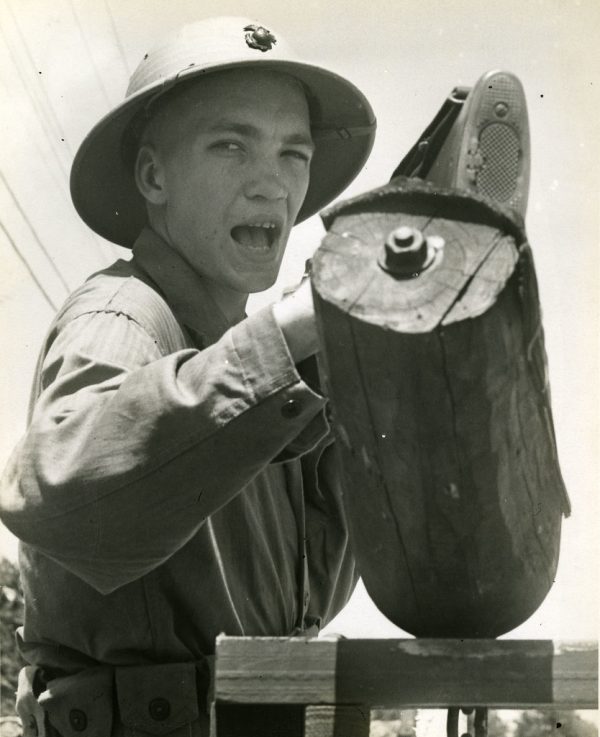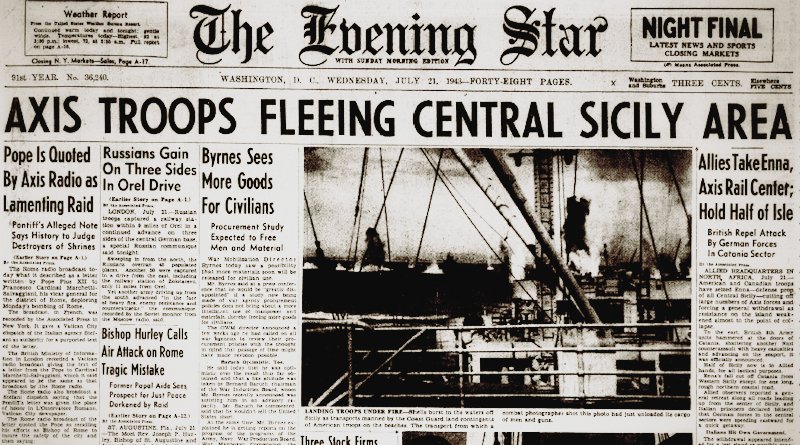World War II Chronicle: July 21, 1943
Click here for TODAY’S NEWSPAPER
On page two, Gen. Dwight Eisenhower predicts Allied forces will see slow progress against the Germans and Italians due to heavy resistance on the British and Canadian front and Sicily’s rugged terrain… David W. Chennault, son of former Flying Tiger commander Maj. Gen. Claire L. Chennault, is listed as one of the sailors rescued from a Japanese-held island following the sinking of the cruiser USS Helena (see page three). You have to wonder what it must be like to command an organization as large as Gen. Chennault’s 14th Air Task Force when you not only have four sons in the war to worry about, but knowing that one child was aboard a ship sunk in enemy waters. Thousands of miles away there’s nothing you can do about it but pray and focus on your part of winning the war…
It’s hard to make out and I couldn’t find a better version of the picture but the Army Air Force is trying out a new “crash” truck for gasoline fires (see page six), like you’d see from an airplane crash. Fuel fires are difficult to put out because oil and gasoline float, and spraying water into a fuel fire can only make it worse if you don’t know what you’re doing or especially if you aren’t using foam…
George Fielding Eliot discusses Sicily on page 10… Sports on page 17… Eddie Rickenbacker’s son David is pictured on page 30 as he is sworn into the Marine Corps. David’s younger brother William will join the U.S. Air Force in 1951, flying transports during the Korean War. William becomes a libertarian, and writes for National Review magazine. William F. Buckley, who founded National Review, is currently a college student in Mexico and will be commissioned a second lieutenant in the Army next year.

Roving Reporter by Ernie Pyle
SOUTHERN SICILY — When I went ashore on the south coast of Sicily about six hours after our first assault troops had landed, the beach already was thoroughly organized.
It was really an incredible scene. Incredible in that we’d done so much in just a few hours. It actually looked as though we’d been working there for months. Our shore troops and Navy gunboats had knocked out the last of the enemy artillery on the hillsides shortly after daylight.
From then on that first day was just a normal one of unloading ships on the beach as fast as possible. The only interruption were a half dozen or so lightning-like dive bombings.
The American invading fleet was divided into separate fleets and each invaded a certain section of the coast and operated entirely independently from the others. The fleet I was with carried infantry and was on the western end of the invasion. Our designated territory covered about 14 miles of beach front.
Our fleet had hundreds of ships in it, all the way from tiny sub-chasers up to powerful cruisers. The bulk of it, of course, was made up of scores of new landing craft carrying men, trucks, tanks, supplies of all kinds.
Perhaps you visualize our whole force having been unloaded from big boats into tiny ones, then taken ashore. That happened only to the big transports which used to be ocean liners and we had none of these in our special fleet. Actually every ship in our fleet, except the gun boats, were capable of landing right on the beach. They were flat bottomed and could beach themselves anywhere.
When daylight came this immense fleet lay like a ablanket out over the water extending as far out in the Mediterranean as you could see. There wasn’t room to handle them all on the beach at once so they’d come in at signals from the command ship, unload, and steam back out to wait until enough of them were unloaded from the convoy to go back for a second load.
Little craft, carrying about 200 soldiers, could unload in a few minutes but the bigger ones with the tanks and trucks and heavy guns took much longer. It was not an especially good beach for our purposes for it sloped off too gradually, making the boats ground 50 yards or more from shore.
Most of the men had to jump into waist deep water and wade in. The water was cold but a cold wind dried off your clothes in less than a half an hour. Your shoes kept squishing inside for the rest of the day. As far as I know not a man was lost by drowning in the whole operation.
The beach itself was immediately organized into a great metropolitan-like docks extending for miles. Hundreds of soldiers wearing black and yellow arm bands with the letters SP standing for Shore Police directed traffic off the in-coming boats.
Big white silken banners about five feet square tied to two poles and with colored symbols on them gave the ships at sea the spot where they should land. On the shore painted wooden markers were immediately set up directing various units to designated rendezvous areas.
There were almost no traffic jams or road blocking. Engineers had hit the beach right behind the assault troops. They laid down hundreds of yards of burlap and laid chicken wire on top of it making a firm roadbed up and down the beach.
Our whole vast organization on shore took form so quickly it just left you aghast. By midafternoon the countryside extending far inland was packed with vehicles and troops of every description. There ere enough tanks sitting on one hillside to fight a big battle. Jeeps were dashing everywhere. Phone wires were laid on the ground and command posts set up in orchards and old buildings. Medical units worked under trees or in abandoned sheds.
The fields were stacked with thousands of boxes of ammunition. Field kitchens were being set up to replace the K rations the soldiers had carried on with throughout that first day.
The Americans worked grimly and with great speed. I saw a few cases of officers being rather excited but mostly it was a calm, determined, efficient horde of men who descended on this strange land. The amazed Sicilians just stood and stared in wonder at the swift precision of it all.
Evening star. (Washington, D.C.), 21 July 1943. Chronicling America: Historic American Newspapers. Lib. of Congress.
https://chroniclingamerica.loc.gov/lccn/sn83045462/1943-07-21/ed-1/
